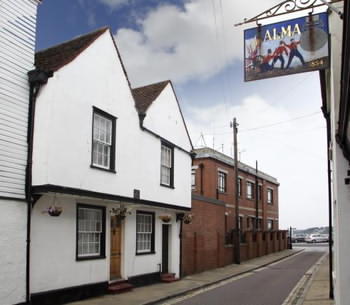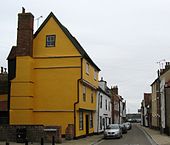|
History of the "MayFlower"
One has to travel back in time to appreciate
how Harwich came to play its part in the Mayflower story. Situated on
the confluence of two rivers, Stour and Orwell, it has a safe natural
harbour which has been used by warships over hundreds of years.
During the Spanish Armada in 1588, Harwich saw 17 000 troops defend it
from Spanish invasion and ships and mariners from the town were involved
in the campaign. Not only an important naval town, it also has a long
history of shipbuilding.
So important was this industry here that Queen Elizabeth I visited in
1561 and inspected the shipyard.
The captain of the Mayflower was a businessman
named Christopher Jones. Jones was born in Harwich, England around 1570
and was the son of a mariner and ship owner, also named Christopher Jones.
Around 1608, Jones purchased the Mayflower
and became its Master, what we would call a captain today, but he was
only a quarter owner of the ship. The other owners were Robert Childe,
Thomas Short and Christopher Nichols.
The Mayflower was a European cargo ship
in the years before its voyage to the New World with the pilgrims. Jones’
first voyage on the Mayflower was to Norway in 1609 where the ship transported
fish, lumber and tar. The ship began leaking during a storm on the way
back to England and the crew had to dump some of its cargo overboard to
save it.
Jones never ventured into the North Sea
with the Mayflower again and instead went back and forth between France
and Spain delivering wine, cognac and vinegar, according to the book "Mayflower:
A Story of Courage, Community and War"
We all take for granted the Mayflower carried
the Pilgrims to the New World, but it would appear this name was used
on many vessels working in the UK.
Over 26 vessels of that name, have been listed in Port documents between
1550 and 1620.
The name "May Flower" was chosen, as it was considered a lucky
plant to 16th & 17th century Mariners.
Out of all these vessels, which was the
genuine one which set sail from Plymouth ?
The name 'Mayflower' was, in fact, very
common in the sixteenth and seventeenth centuries. Besides Scottish and
Irish 'Mayflowers,' of which there were several, there were 'Mayflowers'
belonging to almost every port in England
There were MayFlowers of Aldeburgh, Brightlingsea, Bristol, Chester, Dover,
Grimsby, Looe, Lyme, Lynn, Maidstone, Millbrook, Newcastle, Plymouth,
Portland, Rye, St. Ives, Sandwich, Scarborough, Shoreham, Southwold, Stockton,
Stonehouse, Swansea, York, Weymouth, and Whitby. (total 26)
Although the same ship is not always described as belonging to the same
port, some of the larger ports such as Ipswich, London, Newcastle, and
Yarmouth, possessed two or even several 'Mayflowers' apiece.
There may well have been forty or fifty 'Mayflowers' existing between
1550 and 1700.
Ref:
R.G. Marsden, "The Mayflower" 1904, Page 670
The same ship is frequently described as
belonging to different ports. Christopher Jones's 'Mayflower' is described
some times as 'of London' and twice as 'of Harwich.' She may nevertheless
have been owned in Aldeburgh, Ipswich, or elsewhere.
|
|
The Mayflower
was built locally in Harwich,
but the precise shipyard where it was constructed, as far as I am
aware has never been documented
However today there is still the "Navy Wharf Dockyard
which is still in use by RORO ferries travelling to Scandinavia.
The yard was was originally established during the reign of Edward
II in 1326, and was enlarged during the reign by Elizabeth I of
England.
Queen Elizabeth 1 is documented as visiting the yard in 1561
So it`s very likely the Mayflower
was built at this yard, especially as no other shipyard is mentioned
in Harwich.
As regards to the Mayflowersw connection
with Harwich, the port is frequently used by ships bound either
to Ipswich, Mistley or to Aldeburgh.
It`s located at the entrance to the Rivers Orwell and Stour.
The Orwell flows onwards to the Port of Ipswich, whils`t the Stour
terminates at Mistley for sea going ships
Likewise, vessels wait at Harwich until the high tide, when they
can cross the sand bank at Orford Haven on route to the River Alde
and into Aldeburgh.
|
R.G.Marsden in his book, mentions that
"Master Jones and his ship were Whaling at Cherrie Island".
He also states, there were other indications pointing to the conclusion
that Jones`s Mayflower may have been a "Whaler" before 1610.
Other documents revealed that the Mayflower was purchased from the "Greenland
Whale Fishery Company", who had used Harwich as its home base during
the Whaling season.
So we can safely conclude, that the
"Mayflower" was most likely a Whaler before she was acquired
by Christopher Jones, to work from the Port of Harwich.
Note:-this whaling claim has not been proved
Master of the MayFlower
 Christopher Jones house
Christopher Jones house
Kings Head Street
 Kings Head Street, typical Sailmakers
Cottage circa 1600
Kings Head Street, typical Sailmakers
Cottage circa 1600 |
The Mayflower
was built locally in Harwich, it may well have been in the Dockyard
which is still in use today by RORF ferries to Scandinavia
Sadly this Dockyard with all it history is due to be demolished
and replaced with hundreds of residential
properties
Now let us turn to the Master of
the ship, Christopher Jones.
The Harwich Society publishes this report of his wedding:-
Few of the guests gathered for
the wedding at St Nicholas Church, Harwich on December 23rd 1593
would have had any inkling that the bridegroom was to become a figure
of international and historical importance. The young mariner was
Christopher Jones and his bride to be Sara Twitt, the 17 year old
daughter of his neighbour across the street.
Sara lived in the property opposite,now known as the Alma Public
House
Captain Christopher Jones house is
within a few minutes walk of the yard.
It can clearly be seen at the end of Kings Head Street, when standing
near to the Harwich
Harbour Ferry
Admiralty records indicate on 14
Jan. 1610, Christopher Jones is described as of Harwich, and his
ship is called the 'Mayflower' of Harwich.
In 1613 the 'Mayflower,' Christopher Jones as Master, was twice
in the Thames, once in July and again in October and November.
Again the Admiralty Court records in 1620 documents, Christopher
Jones as "Master" and his 'Mayflower.'
|
So in conclusion, we have the MayFlower documented as a Harwich Vessel,
with its Master also living in Harwich.
Christopher Jones instead of carrying wine
and other goods, on this journey would be fare paying passengers.
The responsibility was enormous and
little did he know, how important the journey ahead would be for generations
to come.
Indeed, just one wrong decision and the course of History would have been
changed for ever.
Researched Alan Beales
This information has been supplied
courtesy of:-
Download:- The Genuine MayFlower by R.G.Marsden
The
Mayflower of Harwich by Paul Simmons
Christopher Jones courtesy of the Harwich Society
USA Connections with acknowledgment to
Michelle Coughlin
Boston
( Mass) Globe Newspaper 2013
Plymouth
2020
Plimoth
Plantation
Published 07/12/2016
updated 11/12/2016, Project on hold
Update 17/08/2017 Harwich Project appears abandoned
Updated 07/07/2019
|

